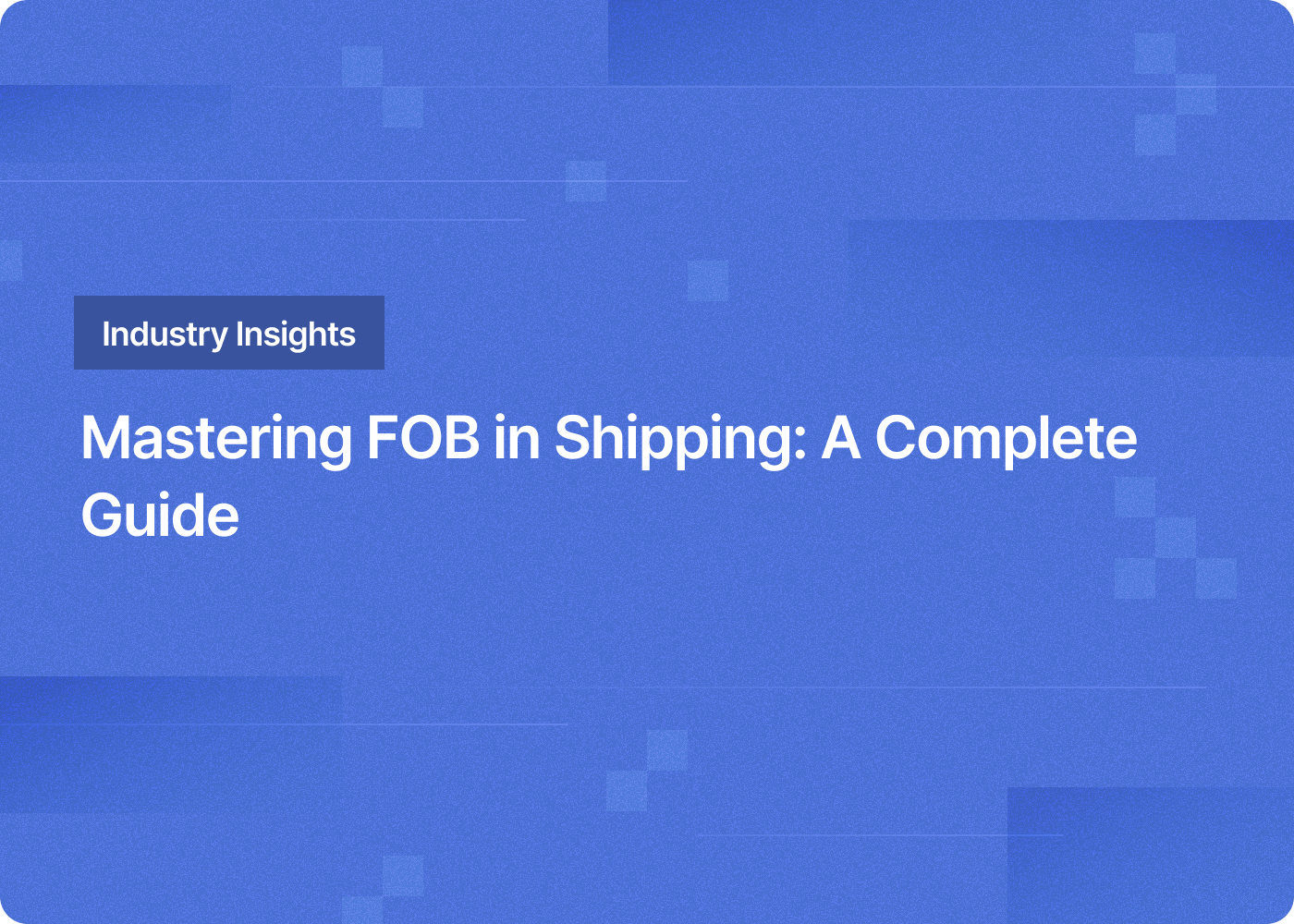Whether you’re a buyer puzzled by freight charges or a seller navigating the shipping process, understanding the term FOB, or “Free on Board,” is crucial. In the intricate realm of the shipping industry, FOB is more than just a buzzword. It’s the cornerstone that defines who pays for shipping costs, who assumes ownership, and where responsibility begins and ends between a buyer and seller.
In this comprehensive guide, you’ll find key insights into the nuts and bolts of FOB—from its basic meaning to its various designations like FOB shipping point and FOB destination. You’ll learn about freight prepaid options, when freight collect makes sense, and how these terms affect your bottom line and supply chain. Master the FOB terms, become savvy in international shipping, and take control of your shipping costs and responsibilities.
What Does FOB Mean in Shipping?
FOB stands for “Free on Board,” a term that originated from maritime law. This phrase has been indispensable in international trade and the shipping industry for centuries. While the concept has evolved over time, the core idea remains the same: establishing the point at which the buyer assumes responsibility and ownership of goods during transportation.
The critical juncture in any FOB agreement is often the shipping point—whether it’s a loading dock, shipping port, or any originating port. When a seller records that goods have been safely loaded onto a shipping vessel, FOB terms like “FOB Origin” or “FOB Shipping Point” indicate that the buyer is now responsible for all shipping costs and risks.
Understanding FOB is essential because it helps both parties determine ownership, outline who is responsible for transportation costs, and specify who files claims if goods are damaged en route. This single term has far-reaching implications on freight charges, shipping documents, and even payment terms, affecting every facet of the shipping process.
Understanding Shipping Point vs FOB Shipping Point
The term “shipping point” might seem straightforward, but when paired with FOB, it takes on a much more nuanced meaning. A shipping point generally refers to the location where goods begin their journey to the final destination. This could be a seller’s loading dock, a shipping port, or an originating port where a freight forwarder consolidates shipments.
In contrast, “FOB Shipping Point” is a specific term that determines when the buyer assumes ownership and becomes responsible for all costs and risks associated with transporting the goods. Essentially, as soon as the seller ships the products and they are safely loaded onto a shipping vessel at the shipping point, the buyer assumes title and the responsibility for shipping costs and potential damages.
By understanding the subtle yet significant differences between a shipping point and FOB shipping point, you can navigate shipping terms more effectively, avoiding misunderstandings that could result in unexpected freight costs or shipping delays.
Freight Prepaid: How It Works
One of the most commonly used terms in FOB agreements is “Freight Prepaid.” In this context, freight prepaid means that the seller pays the shipping costs and retains ownership of the goods until they arrive at the buyer’s destination. Essentially, when the seller delivers the goods and ships them, they’re taking care of all the transportation costs up to the final destination. This often involves specifying in the shipping documents that freight is prepaid.
Advantages
-
Simplifies the purchase order process for the buyer
-
Reduces the administrative burden related to filing claims if goods are damaged
-
Gives the buyer a clearer understanding of total costs, as the freight charges are included in the initial price
Disadvantages
-
Buyer has less control over the shipping process and supply chain
-
Freight costs are often embedded in the product’s price, potentially making it higher
-
Seller’s location can affect the efficiency of freight shipping, especially in international trade scenarios
Freight prepaid is particularly useful when the buyer prefers a hands-off approach, leaving the intricacies of international commercial terms and customs clearance to the seller. However, this method does limit the buyer’s control over the shipping terms, which might be a disadvantage in certain situations.
The Other Side of the Coin: Freight Collect
If “Freight Prepaid” is where the seller takes on the shipping costs, “Freight Collect” flips that script. In a Freight Collect arrangement, the buyer pays for all shipping costs, from the originating port to the final destination. This means that the buyer assumes ownership and responsibility as soon as the goods are safely loaded onto a shipping vessel.
When and Why is Freight Collect Used?
-
Budget Control: By managing the shipping process directly, the buyer can potentially negotiate better rates and avoid hidden freight costs.
-
Supply Chain Management: Allows the buyer to have more control over their supply chain, selecting their preferred freight forwarder or shipping vessel.
-
Customs and Duties: The buyer can streamline customs clearance and international commercial terms, as they have direct oversight of the shipping documents.
Freight Collect is often the choice for businesses that prefer to have full control over every aspect of the shipping process, from selecting shipping terms to managing freight charges. However, this method does place the onus of risk and responsibility firmly on the buyer’s shoulders, from the point of FOB designation to the goods’ arrival at the buyer’s location.
How FOB Affects Shipping Costs and Responsibilities
FOB terms are the linchpin in determining who bears the shipping costs and responsibilities in a transaction. Whether it’s “FOB Origin” or “FOB Destination,” these terms spell out whether the buyer or seller pays the freight charges and at what point ownership passes between the two parties.
Role of the Buyer
-
FOB Destination: The seller pays for all transportation costs, and the buyer is responsible only when the goods arrive at the final destination.
-
FOB Shipping Point: The buyer assumes both ownership and financial responsibility as soon as the goods leave the seller’s location.
Role of the Seller
-
Freight Prepaid: The seller pays all shipping costs and retains ownership until the goods are delivered.
-
Freight Collect: The seller ships the goods, but the buyer pays the shipping costs.
By understanding the implications of different FOB terms, you can navigate the complexities of shipping costs and responsibilities. Whether it’s deciding who files claims for damaged goods or determining the final price, FOB terms affect every aspect of the shipping process.
Other Important FOB Terms and Variations
FOB is not a one-size-fits-all term; it comes with a variety of designations that provide more specific guidance on shipping responsibilities. While “FOB Origin” and “FOB Destination” are standard, there are other terms that offer nuanced differences.
FOB Destination
This term stipulates that the seller pays all transportation costs until the goods arrive at the buyer’s destination. The buyer assumes title and becomes responsible for the goods only at this final destination.
FOB Origin
Also known as “FOB Shipping Point,” this term means the buyer assumes both ownership and all freight costs right from the seller’s location or originating port.
FOB Pricing
In this variation, the price is set at the shipping point, encompassing all costs up to that point but not beyond. FOB pricing gives clarity about how much the buyer will pay before additional shipping costs.
Free Alongside Ship (FAS)
This is an alternative term often used in international shipping. The seller delivers the goods alongside a shipping vessel chosen by the buyer at a specified port.
Understanding these variations can profoundly affect your supply chain and your ability to manage shipping costs effectively. These terms determine ownership and payment responsibilities, influencing everything from shipping documents to customs clearance.
Common Mistakes and How to Avoid Them
Even with a clear understanding of FOB terms, mistakes can happen, leading to increased shipping costs, shipment delays, or even legal complications. Here are some common pitfalls and how to avoid them.
1. Vague Contracts
Avoid contracts that are ambiguous about FOB designations or shipping point locations. Clarity in your FOB agreement is crucial for defining responsibilities.
2. Ignoring Insurance
Whether you’re the buyer or the seller, neglecting insurance can leave you exposed to risks during international trade, especially when shipping via a freight forwarder.
3. Miscommunication
Be explicit in your communications, especially regarding freight charges and when ownership passes between buyer and seller. Misunderstandings can lead to disputes that delay shipments.
Tips for a Watertight FOB Agreement
-
Documentation: Always keep well-maintained shipping documents.
-
Open Communication: Maintain a clear line of communication with the other party.
-
Legal Counsel: For complex deals, especially in international shipping, it’s wise to consult with experts familiar with international commercial terms and customs clearance procedures.
By paying attention to these details, you can craft a watertight FOB agreement that protects your interests and simplifies the shipping process for all parties involved.
Wrapping up the FOB Guide
Navigating the labyrinthine world of FOB can initially seem overwhelming. However, understanding the nuances between terms like “FOB Shipping Point,” “Freight Prepaid,” and “Freight Collect” can empower you to make informed decisions that could significantly impact your shipping costs and responsibilities. The key is to keep your shipping documents clear, maintain open lines of communication, and consult experts when necessary. Armed with this knowledge, you’re well on your way to mastering FOB and steering your supply chain more effectively.



